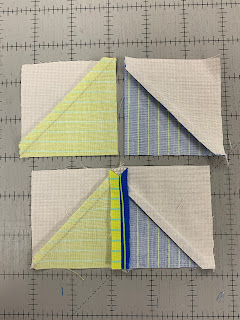I have tested patterns for years. Some as part of my work with The Quilt Show, some for other jobs and most for myself. You may be surprised to know that there are sometimes errors in patterns that are not caught in proofreading. It pays to check things out before you cut a lot of pieces.
Three years ago I made this sample top for the Stitchin Heaven Scrappy Happy cruise that was to be in April 2021, which, was canceled:
Scrappy Plus Quilt was first published in a magazine. The pattern said the blocks were 15" finished. While making the quilt, I found the outside perimeter triangles were a bit small so I increased the size of the square used to cut the Quarter Square Triangles by 1/4".That helped.
Jump ahead 3 years. I had sent the top back to Stitchin Heaven and they had it quilted. A new Scrap Happy cruise happened March 11-18, 2023. I was sent a new Kit to use to make step-outs for the cruise.
The step-outs are parts. I use them in class. Once home, I started putting the blocks together and found they were a bit bigger than 15.5", as would be the expected size for a 15" finished block. Many of the students had the same experience.
QUILTERS MATH to the rescue. Let's check this block out. In testing a pattern, you have to know what the finished sizes are of at least some units to be able to calculate what size to cut the parts.
This block has a square block in the middle which is surrounded with four neutral corners:
We are able to figure out what size that middle block is based on the cut size of the squares used, listed in the pattern:
Since the squares are CUT 3.25" they finish at 2.75". The Half Square Triangle units would have to be trimmed to 3.25" so they fit next to those squares. And FOUR 2.75" finished units mean this center part of the complete block is 11" finished, 11.5" including seam allowances.
Now I want to know what size the larger block will be when set on point and the four neutral corners are added.
Time to use one of those MAGIC NUMBERS: to calculate the diagonal of a square, multiply the 11" finished measurement x 1.4142 = 15.5562". That is slightly more than 15.5" FINISHED so I would just call it a 15.5" FINISHED BLOCK, not 15". With SEAM ALLOWANCES, the block should be about 16".
Because I increased the size of the square used to cut those outside perimeter Quarter Square Triangles, I had a bit of fabric beyond the 16" block to trim away, no more than 1/8". I trimmed each block to 16" and was then able to join them together.
One other tip I give in class, is to ruler check yourself as you go. If there are piecing problems, you want to find them as soon as they happen, not when a 15.5" block is done.
Here I have sewn two HST together. 2.75" + 2.75" = 5.5" + .5 seam allowance--these two units should be 6" including seam allowance:
When the row of four 2.75" units are sewn together they should measure 4 * 2.75" = 11 + .5" seam allowance: 11.5"
If the units are not the right size now, they will not miraculously become the right size when you do the next thing. By finding my mistake as soon as it happens, I can fix it AND prevent making the same mistake again.
There are only 3 things we can do wrong in piecing a block: the cutting, the sewing, and/or the pressing. Do your best on all three steps and you will have blocks that turn out the correct size every time. Well, OK, almost every time. Sometimes things just happen...
Because I don't need another 62" x 77.5" quilt I am going to make baby quilts from these blocks. 2 x 6 blocks = 31" x 46.5, that's OK. Or I could add a bright, happy border fabric to enlarge it some. Or use 9 blocks for a 46.5" square baby floor throw. Lots of possibilities.
If you want MORE INFORMATION ON QUILTERS MATH, I have a detailed TUTORIAL on the subject. Find it under TUTORIALS, listed above OR here:
SIMPLE MATH FOR QUILTERS
It pays to be able to check pattern measurements BEFORE you begin in case there are errors. It isn't easy to write patterns, and errors sometimes slip in. Pattern designers are upset when they do, they are not there intentionally, I assure you.
Understanding QUILTERS MATH can save you time and effort AND allow you to design your own blocks and quilt patterns.
Let's quilt,
Barbara











































































